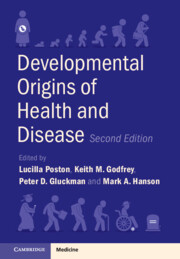Book contents
- Developmental Origins of Health and Disease
- Developmental Origins of Health and Disease
- Copyright page
- Contents
- Contributors
- Preface
- Section I Overview
- Section II Exposures Driving Long-Term DOHaD Effects
- Chapter 2 The Evolutionary Basis of DOHaD
- Chapter 3 Timing
- Chapter 4 Long-Term Effects of Food Insecurity and Undernutrition in Early Life
- Chapter 5 Short- and Long-Term Effects of Maternal Obesity and Dysglycaemia for Women and Their Children
- Chapter 6 Long-Term Effects of Prenatal Maternal Stress and Mental Health
- Chapter 7 Environmental Exposures in Early Life
- Chapter 8 Developmental Programming and the Microbiome
- Chapter 9 Exposures Driving Long-Term DOHaD Effects
- Section III Outcomes
- Section IV Mechanisms
- Section V Interventions
- Section VI Public Health and Policy Implications of Interventions
- Index
- References
Chapter 7 - Environmental Exposures in Early Life
Effects of Air Pollution, Chemicals and Climate Change on Human Health and Wellbeing
from Section II - Exposures Driving Long-Term DOHaD Effects
Published online by Cambridge University Press: 01 December 2022
- Developmental Origins of Health and Disease
- Developmental Origins of Health and Disease
- Copyright page
- Contents
- Contributors
- Preface
- Section I Overview
- Section II Exposures Driving Long-Term DOHaD Effects
- Chapter 2 The Evolutionary Basis of DOHaD
- Chapter 3 Timing
- Chapter 4 Long-Term Effects of Food Insecurity and Undernutrition in Early Life
- Chapter 5 Short- and Long-Term Effects of Maternal Obesity and Dysglycaemia for Women and Their Children
- Chapter 6 Long-Term Effects of Prenatal Maternal Stress and Mental Health
- Chapter 7 Environmental Exposures in Early Life
- Chapter 8 Developmental Programming and the Microbiome
- Chapter 9 Exposures Driving Long-Term DOHaD Effects
- Section III Outcomes
- Section IV Mechanisms
- Section V Interventions
- Section VI Public Health and Policy Implications of Interventions
- Index
- References
Summary
The environment is responsible for one third of the global disease burden. The rapid and critically timed developmental period before birth and during early childhood is particularly sensitive to disruption by environmental factors, leading to both immediate and long-term effects. The scope of environmental hazards is extensive and exposure is widespread. This chapter will describe the effects of air pollution, chemicals and climate change. Air pollution is associated with adverse pregnancy and birth outcomes and particularly affects respiratory health in children. Many chemicals are present in everyday life, and early life exposure is associated with a wide range of non-communicable diseases. Climate change will affect the basic requirements for health and increase exposure to air pollution, chemicals and trauma, bringing about greater health inequities. Investing in healthy environments in early life will give the next generation the best chance to reach their developmental potential and live a long and healthy life.
- Type
- Chapter
- Information
- Developmental Origins of Health and Disease , pp. 56 - 65Publisher: Cambridge University PressPrint publication year: 2022



